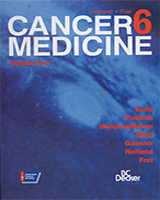By agreement with the publisher, this book is accessible by the search feature, but cannot be browsed.
NCBI Bookshelf. A service of the National Library of Medicine, National Institutes of Health.
Kufe DW, Pollock RE, Weichselbaum RR, et al., editors. Holland-Frei Cancer Medicine. 6th edition. Hamilton (ON): BC Decker; 2003.

Holland-Frei Cancer Medicine. 6th edition.
Show detailsCemento-Ossifying Fibroma (Ossifying Fibroma, Cementifying Fibroma)
In contrast to the radiographically similar but much more common focal cemento-osseous dysplasia, this lesion is a true neoplasm. It belongs to the class of benign fibro-osseous lesions (BFOLS), which are pathophysiologically diverse but microscopically similar.
Clinical
This tumor occurs in young patients as a slow growing, painless mass expanding the mandible that may displace teeth. It occurs with equal frequency in both sexes with the greatest incidence in the third and fourth decades. Although it may occur in either jaw it much more frequently affects the mandible (Figure 91-17).56

Figure 91-17
Clinical appearance of cemento-ossifying fibroma presenting as a painless, expansile mandibular mass. (Four-color version of figure on CD-ROM)
Radiographic
This lesion has a centrifugal growth pattern. It is well circumscribed, and its density varies from lucency to opacity. At first it is well demarcated but later becomes more mineralized and relatively less well localized. It may cause root resorption or divergence. In the mandible it may expand the inferior cortex (Figure 91-18).

Figure 91-18
Radiograph of cemento-ossifying fibroma with presentation as a radiolucency with corticated borders and bony enlargement.
Differential Diagnosis
The differential is between the cemento-ossifying dysplasias, juvenile ossifying fibroma, osteoblastoma and osteoma.
Histopathology
The lesion is well demarcated from peripheral tissues, unlike focal cemento-osseous dysplasia with which it is often confused. It may occasionally be encapsulated. The stroma is cellular and contains foci of rounded calcified masses and other calcifications with a trabecular pattern that resembles cementum and osteoid. Spicules of bone are randomly distributed within the stroma and they are rimmed with osteoblasts and osteoclasts. Loose and dense areas of fibrous stroma occur with occasional whorling. There is no stromal hemorrhage and giant cells are not present.56
Treatment
Enucleation and curettage is sufficient treatment. Recurrence rates are very low. Occasionally very large lesions have been encountered that have been neglected by patients because of the painless pattern of extended growth. These may require formal resection because of complete replacement of a significant component of the jaws by the tumor.
Nonneoplastic Lesions of Periodontal Ligament Origin
These are not tumors but there are three lesions to consider in order to avoid errors in treatment particularly from the point of view of excessive treatment.
Periapical Cemental (Cemento-Osseous) Dysplasia
This is a radiographic finding that could lead to unnecessary endodontic therapy. These lesions occur predominantly in adult black women, usually at the apices of the lower incisor teeth. They present as symmetrical periapical radiolucencies that resemble periapical abscesses or granulomas. They start as lytic lesions and with time progress through stages of calcification until they mature into radiopaque lesions rimmed by a thin radiolucent line or band. The teeth are vital. The earliest stage histologically corresponds to fibrosis in the periapical bone. In the mixed density stage cementum and/or bone is deposited within the fibrous stroma and in the last or mature stage there is extensive cementum or bone formation. No treatment is required.57
Florid Cemental (Cemento-Osseous) Dysplasia
This occurs in the same group of black females. Osteoid and cementum are deposited in a fibrous stroma and two or more quadrants are affected. It is not at all unusual to observe this in all four quadrants. There is no pain and it is not related to infection. Unfortunately the bone is relatively poorly vascularized and when these areas are biopsied the bone is found to be very dense and poor healing ensues. No treatment is required but when teeth are removed the patient has to be informed of the likelihood of delayed healing, postoperative pain from the exposed bone and a very long recuperation. It is a diagnosis by inspection of the radiographs (Figure 91-19).

Figure 91-19
Florid cemento-osseous dysplasia with the classic radiographic appearance. Courtesy of Gary Clayman, DDS, MD. (Four-color version of figure on CD-ROM)
Focal Cemento-Osseous Dysplasia
This lesion is of interest because it resembles cementifying (ossifying) fibroma.
The focally expressed cementifying ossifying dysplasia is one of two different forms of the same reactive bone lesion. These lesions are usually asymptomatic and are focal in nature. They appear as mixed density or radiolucent lesions with ill-defined borders in the tooth bearing regions of the jaws. The focal form is most common in the posterior jaws in areas of previous tooth extraction. Histologically, the focal and periapical forms of cemento-osseous dysplasia are the same. The calcified components of the lesion show thick curvilinear bony trabeculae referred to as “ginger roots” and the cementoid masses are irregularly shaped. The noncalcified tissue has a sinusoid-like vascular network that is closely associated with bony trabeculae. Free hemorrhage occurs throughout the lesion and there is a loose collagenous fiber system between the “ginger roots” and the cemental masses.57
No treatment is required for this lesion.
- Tumors Arising from the Periodontal Membrane - Holland-Frei Cancer MedicineTumors Arising from the Periodontal Membrane - Holland-Frei Cancer Medicine
Your browsing activity is empty.
Activity recording is turned off.
See more...